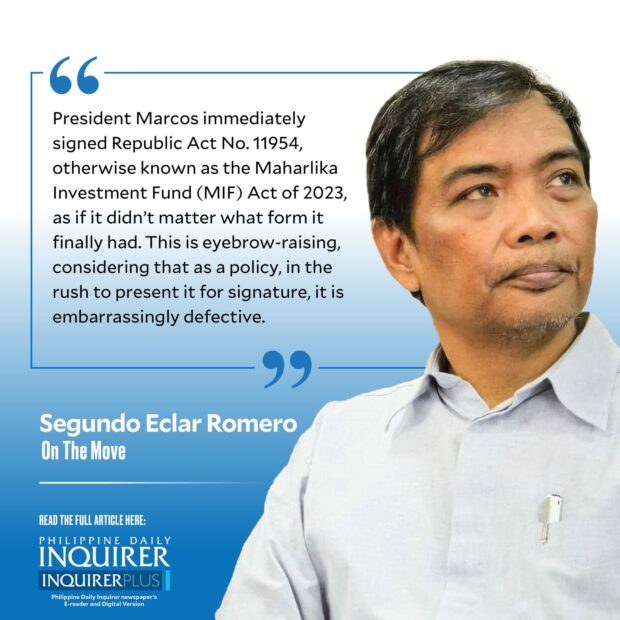
First, considering the law was all of 9,160 words, it failed to set out the most important information—what was the purpose of the law? Couldn’t this law be integrated with the goals of the Philippine Development Plan to provide it nuance?
Sure, the statement of policy rattled off some concepts, The law had a statement of policy, but it was an indolent statement of a once-in-a-lifetime gamble with the people’s money.
Here are the concepts bandied about by the law, without even providing a definition or context of the use of each: 1. to generate, preserve and grow national wealth; 2. create jobs; 3. promote trade and investments; 4. foster technological transformation; 5. strengthen connectivity; 6. expand infrastructure; 7. achieve energy, water, and food security; 8. promote economic growth; 9. accelerate job creation; 10. improve the welfare of Filipinos; 11. preserve and optimize the use of government financial assets to generate returns; 11. support the infrastructure development agenda of the government; 12. promote efficient intergenerational management of wealth; 13. recognize the country’s natural capital and its role as the basis for the economy.
As a policy, it didn’t have a problem and objective tree analysis that could have buttressed the solution. In other words, the solution preceded the analysis of the problem.
Next, there was no showing of a SWOT (strengths, weaknesses, opportunities, and threats) analysis that could have consolidated and parsed the pluses and minuses. A TOWS matrix would have helped identify the right strategy. What makes a Maharlika investment law the right policy instrument?
Oh, there was also no stakeholder analysis, either, a crucial step. Was there even a single focus group discussion that was conducted for this bill? Who benefits most from the law? Who are the eventual target beneficiaries of the MIF?
Because of these nebulous infirmities, the law is poorly anchored and subject to managerial discretion, the threshold to corruption.
Finally, the bill was passed without sandboxing, scenario building, and iterative design. What’s the point of having detailed accountability systems if the purpose of the law is not clear? Because of this, it is a “bahala na” law.
But the reality is that the law has been signed, and we have to live with it. This is not a done deal. The implementing rules and regulations for the implementation of the law is a new battleground. This process should be open to the public.
I think we should not leave it to the government to slap the hands reaching into the cookie jar. Civil society organizations should self-mobilize. There has to be a special-purpose civil society body that will monitor the implementation of the MIF.
Some time ago, we had a robust civil society anti-corruption network, the Transparency and Accountability Network (TAN). We need to start up this network once again to monitor the implementation of the MIF.
In fact, instead of just being a watchdog, a new TAN can contribute key stakeholder perspectives that will make MIF initiatives more responsive to the needs of the people.
A university with expertise in investments should develop a special, dedicated course for civil society organizations so they can play a vital watchdog role in the MIF. This will be a good continuing check on the progress of the implementation of the law.
Civil society organizations can also conduct independent research and analysis on MIF investments and practices. They may assess the social and environmental impacts of investments, as well as examine the alignment of the fund’s activities with the country’s development goals. Independent analysis helps shed light on potential issues and holds the fund accountable for its actions.
Another worry that must be addressed is the bias for large enterprises. To control the tendency of government investment schemes to focus solely on medium and large enterprises and ensure a more inclusive and equitable approach to investment, several countermeasures need to be implemented. These measures aim to promote support for small and micro-enterprises, which are crucial for employment generation and economic development in this country.
But who will awaken the Transparency and Accountability Network?
doyromero@gmail.com

